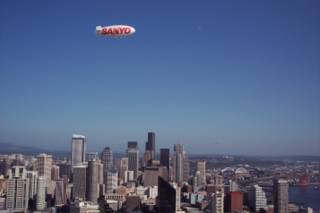Monday, October 11, 2004
Stacks
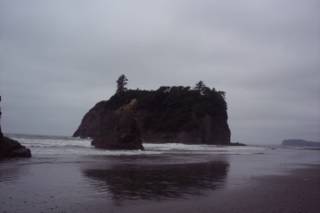
Washington State coast from late July 2004, - first time there, and....well.....! Note that just a few miles inshore the weather was great, not clouds or anything. We still had a great time there. I will post some tidal pool shots with starfish and anemones at a later time.
This also illustrates another issue I have had with the DX7630 - the greens appear to be under-represented (under saturated?). I am trying another setting (enchanced vs natural color) to see if that improves the situation. Will report later.
Galveston - Washington ....each has its advantages. The water in the northwest, surrounded by beautiful and dramatic scenery was too cold to go into even in late July. The water in Galveston in October was perfect.
Cameras
I have been using a higher end consumer camera (Kodak DX7630) for the last few months, and I feel that the results are somewhat mixed. I have gotten a lot of very good images, but it seems to be somewhat of a shooting match to get them in marginal lighting situations.
I have been using the camera in 5.4 megapixels per image mode, even though it goes up to 6.1 megapixel per image. I suppose part of the reasoning for this it that I want to take as many pictures as I can on my storage card with suitable resolution, and I think that maybe 6.1 megapixels is perhaps overkill for a consumer camera (but I wanted that option anyway ;^{) ). Another concern is that the camera only supports JPEG (.jpg) images. There is not an option for "native" or "raw" format pictures, i.e. the compression is always lossy. I wish that I could save in .tiff or other non-lossy format, even if it took additional memory. Memory is cheap and getting cheaper all the time.
One other complaint- and this may be fairly generic to most digital cameras. It appears that only a small variation in background lighting causes a very large difference in the aperture/exposure setting. My 20 year old Canon AE-1 seems to do a much better (more consistent) job under low light conditions. Is this a common problem with modern digital cameras? I have also heard similar complaints about some of the Sony cameras.
I have been using the camera in 5.4 megapixels per image mode, even though it goes up to 6.1 megapixel per image. I suppose part of the reasoning for this it that I want to take as many pictures as I can on my storage card with suitable resolution, and I think that maybe 6.1 megapixels is perhaps overkill for a consumer camera (but I wanted that option anyway ;^{) ). Another concern is that the camera only supports JPEG (.jpg) images. There is not an option for "native" or "raw" format pictures, i.e. the compression is always lossy. I wish that I could save in .tiff or other non-lossy format, even if it took additional memory. Memory is cheap and getting cheaper all the time.
One other complaint- and this may be fairly generic to most digital cameras. It appears that only a small variation in background lighting causes a very large difference in the aperture/exposure setting. My 20 year old Canon AE-1 seems to do a much better (more consistent) job under low light conditions. Is this a common problem with modern digital cameras? I have also heard similar complaints about some of the Sony cameras.
Shrimp Boat Offshore Galveston Island
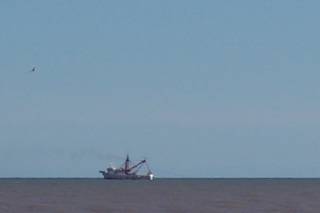
A shrimp boat at work offshore. I took this using maximum digital zoom on the DX7630. The boat was probably working a couple of miles offshore; it appeared to be one of three or four active offshore of where we were today. Steadied the camera on a post set out to control erosion. Note the bird in the upper left - saw a lot of Kingfishers today, looks like maybe that was one.
Galveston Island Beach
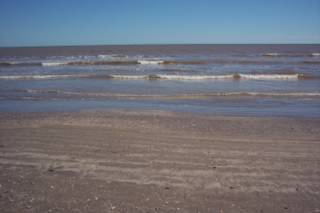
A beach near Pirates Cove, Galveston Island, today. Almost perfect weather; October is great in Texas. (Kodak DX7630)
Friday, October 08, 2004
Miss Dixie
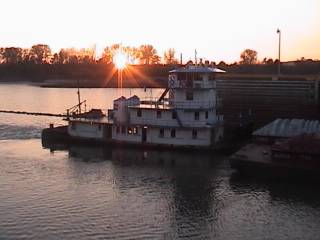
A tug on the Arkansas River, Toad Suck, Arkansas, Novermber, 2001. (Sony DCR-TRV17 in single image mode)
Western Kazakhstan
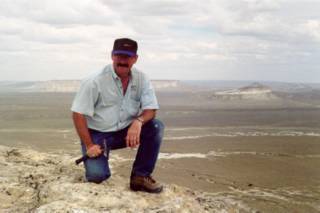
A photo taken June 1999 on a field trip in the Shetpe area of western Kazakhstan. Our group had climbed to the top of a chalk hill to have a look at the upper Cretaceous/Danian carbonates in the area. On the right side of the picture is a mesa like structure completely surrounded by a steep cliff. In earlier times a fort maintained for the protection of trade routes through the area was situated on the top of the mesa. The fort was only accessible by a stairway carved into the chalk cliff on the back side of the structure. At the base of the hill from where this picture was taken was a labyrinth like, dendritic, erosional network in the lower units of the chalk. This chalk unit is approximately the same age as the Dover chalk in the UK and Austin chalk in the US. I will be posting more pictures from this trip in the future. A very cool place to hike around and look at rocks. (Canon AE-1, scanned from print)
Burr Burner
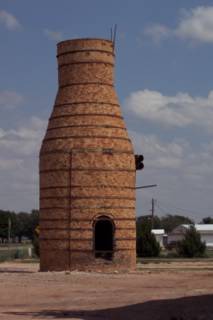
Now for something a little different. This is a cotton burr burner in Ropesville, Texas. I took this in early July while visiting my folks in the town near which I grew up. This is located next to a cotton gin and was used to dispose of the burrs (outer seed hulls) removed by the gin mills in the cotton beneficiation process. This structure is composed of stacked bricks stabilized by iron (steel?) bands and probably dates from the '50's, or earlier, when mechanized cotton harvesting was developing. (Kodak DX7630)
